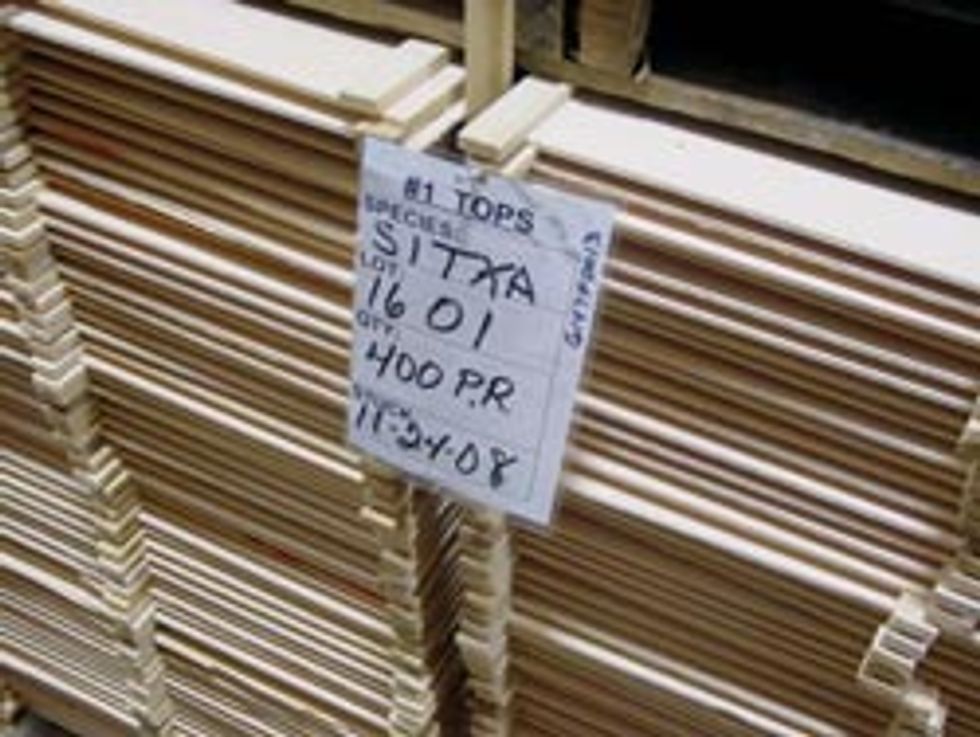What I love about guitars is that they are not only magnificent works of art—they are, like a paintbrush is to an artist, the practical and creative tools that musicians use. And even though the art of inlay and marquetry has risen to an unprecedented level, the decoration on a guitar is just that—decoration. It’s pretty and it has value, but I haven’t come across any evidence that mother of pearl or abalone shell has any better tonal properties than a pebble, or a piece of plastic for that matter.
Wood is where the tone is! I’ve heard every story in the book about the secrets of tone, from soaking spruce in shrimp shell brine to blasting your guitar case with your stereo speakers! My favorite story is about the harvesting of spruce in Stradivari’s time. The obscure legend has it that high-elevation alpine spruce trees were necessarily cut in the late winter prior to the thaw. The violin makers would wait at the base of the mountain and listen as the spruce logs were cut and sent down the mountain in snow troughs. The logs that made a distinct whistling sound as they flew down the mountain were the ones chosen for the best violins. Poppycock, you say? Most likely, but it makes a fun story. 
Through the years, I’ve been asked to select wood for hundreds of special guitars. Of course, I would always pick pretty quarter-sawn spruce (we call it pound cake) with tight, straight, even grain and lots of lace (medullary rays), devoid of runout on the center seam. I used to think that this selection process was a bunch of hoity-toity voodoo, but acknowledging that there might be some validity, I learned to hoist each top up to my ear and tap, listening carefully to both the pitch and the intensity. Gradually, I began to differentiate the tap tones of the various species. Sitka spruce seemed to have a low, boomy rumble, while Adirondack red spruce had a significantly higher pitched ping. Engelmann and Italian alpine spruces seemed to fall in between. Now my question was, what relationship could there be between these tapped notes and a finished guitar? After all, there are spectacular guitars made out of all of these spruces. 
I am, however, personally enthralled by two opposing properties of guitars: lightness versus heaviness. Every now and then, I pick up a guitar with mahogany back and sides that is so light in weight, I am immediately startled. Playing such a guitar is almost always a delight. The tone can be described as brilliant, glassine, breathy and crystalline. Conversely, I’ll pick up a guitar with rosewood back and sides, and I’m often struck by the heavier weight of this denser wood. Strumming a chord on these guitars can unleash a depth and resonance that seems to emanate from behind your spine. I used to play an autoharp, and I always loved to place it on the dining room table and strum it. The whole room would resound. It was the absorption of sound conveyed through the extra mass of wood, reverberating and echoing, like singing in the shower! That’s the rosewood sound: dark, warm, thick and full.
So, I think these two opposing tonalities (like the Treble and Bass knobs on your sound system) can be manipulated by the instrument maker’s understanding of lightness or absorption, to yield a wide variation of desirable tone. That only scratches the surface of my fascination with guitars. Each one is a distinct individual, just like the people who make and play them.
Dick Boak
Prior to, and during the course of, his 33-year career with C. F. Martin & Co., dick boak (small letters!) has been a vagabond, communal architect, illustrator, art teacher, geodesic dome builder, lathe turner, luthier, draftsman, poet, guitarist, wood expert, author, desktop publisher, singer/songwriter, apple computer geek, archivist and publisher. By the time you finish reading this paragraph, he will most likely have morphed into something else.

















